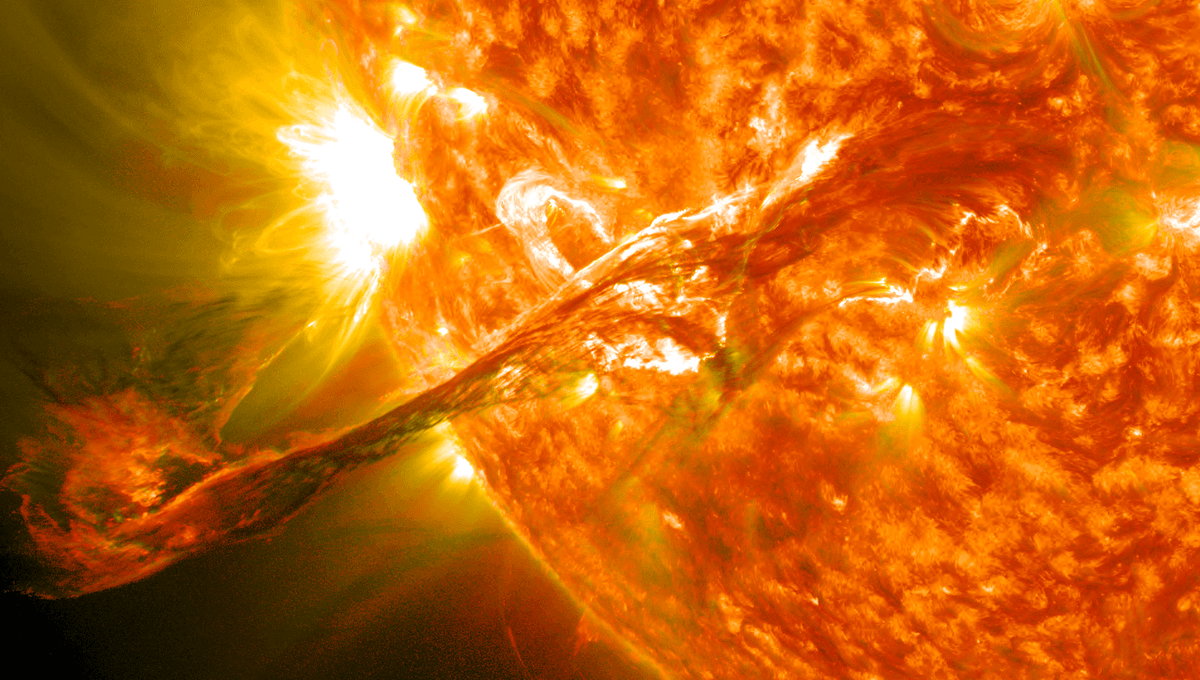
As the Sun spits out more and bigger storms, videos of flares emerging from its surface help us see its power. Watching these, it usually looks like they peter out a few solar diameters away, but the truth is very different. Although the particles that accompany smaller flares can fall back as the powerful solar gravity overcomes the speed with which they are moving, some flares can travel far beyond the Earth and even the outer planets.
Solar flares are localized bursts of radiation produced when energy trapped by twisted magnetic fields gets released suddenly. This accelerates charged particles from the Sun’s plasma.
How far can solar flares travel?
As powerful as the Sun’s gravitational field is, flares can provide so much energy that particles within them can start with velocities a large fraction of the speed of light. A combination of the Sun’s gravity and encounters with the thin material in the not-quite vacuum of space slow these particles down, but cannot stop them. Consequently, flares can travel all the way to the heliopause, the boundary where the solar wind expires, finally lacking the strength to push aside the interstellar medium.
The heliopause, as we learned recently, is far from spherical. So, to answer the second question first, solar flares can travel substantially different distances depending on which direction they are fired in. We haven’t fully mapped the boundaries of the heliopause, but we know it’s about 100-120 Astronomical Units (Earth-Sun distances) at minimum.
Some flares, which happen to be fired off in just the right direction, can probably reach distances of 350 AU or more. A powerful enough flare might even push the boundary out a little further for a while, like a rhinoceros running into a rubber wall.
On the other hand, a few flares will run into the magnetic field around the Earth or another planet that has one, and be stopped a great deal earlier.
In fact, the most obvious part of a flare is the light it emits, and that will travel forever, unless it runs into something. We can see flares from other stars, indicating that in one sense the flare has crossed many light years to reach us. The Sun’s flares are not as big as those of many other stars, but that could still be seen from hundreds of light years away with the right telescope.
Flares may fade in brightness so that we can’t see them long before they reach such distances but that doesn’t mean they aren’t still going.
How big can solar flares get?
If, when asking about a flare’s size, you mean the question literally, then multiply the length, as described above, by the area of the flare. This area varies of course, and can be hard to measure, but flares can leap from areas on the Sun’s surface many times larger than the Earth, and they don’t get smaller as they travel.
References to flares being big, however, are usually about their power. The most powerful flare to be precisely measured was in 2001. This was an X28.6 using the scale on which flares are measured, meaning it carried 2.9 x 10-3 Watts per square meter. That might not sound like much, but spread over an area far larger than the Earth, it sums to an astonishing amount of power.
However, two years later another flare saturated the detectors on the Geostationary Operational Environmental Satellite. It has been estimated to have been an X40 or 45.
But, we know flares can get much larger than this. The Carrington Event in the 19th Century occurred well before we had the capacity to measure flares’ power. However, the effects it triggered, including electrocuting telegraph operators, make clear that this was on a much larger scale than anything we have seen in the space age.
Radiation bursts captured in tree rings may indicate flares orders of magnitude larger still, although this interpretation is disputed.
Either way, it looks as though to find out how powerful flares can get, we can only wait and see.
Source Link: How Big Can Solar Flares Get And How Far Do They Travel?